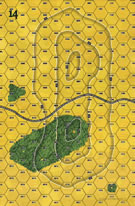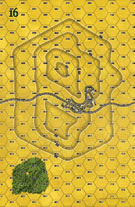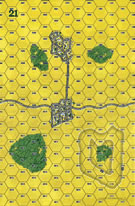Carpathian Panzers
White Eagles #36
|
|
(Defender)
Poland
|
vs |
Germany
(Attacker)
|
|
|
|
Total |
| Side 1 |
1 |
| Draw |
0 |
| Side 2 |
1 |
|
Total |
| Side 1 |
1 |
| Draw |
0 |
| Side 2 |
1 |
|
Total |
| Side 1 |
0 |
| Draw |
0 |
| Side 2 |
0 |
|
| Overall Rating, 2 votes |
|---|
|
|
|
Scenario Rank:
--- of 940 |
| Parent Game |
White Eagles |
| Historicity |
Historical |
| Date |
1939-09-01 |
| Start Time |
05:30 |
| Turn Count |
30 |
| Visibility |
Day |
| Counters |
118 |
| Net Morale |
0 |
| Net Initiative |
2 |
| Maps |
3: 14, 16, 21 |
| Layout Dimensions |
84 x 43 cm
33 x 17 in |
| Play Bounty |
158 |
| AAR Bounty |
227 |
| Total Plays |
2 |
| Total AARs |
0 |
|
Introduction
|
|
Attacking along the railroad leading through one of the few passes in the Carpathians toward the key city of Krakow, the 2nd "Vienna" Panzer Division found its way barred by the tough Polish 1st Mountain Brigade. The tankers called up their own mountain troops to assist, and the two Austrian units pushed forward while the Polish mountaineers called in the armored train "Pierwszy Marszalek" ("First Marshal").
|
|
Conclusion
|
|
The Poles stopped the initial attack, but the arrival of German mountain troops tipped the balance and the brigade fell back in some disorder. Fighting would continue for the hilly valley for the next several days, as the best units of both armies were committed to a bitter struggle before the smaller Polish brigades gave way before the well-supported German divisions.
|
Display Relevant AFV Rules
| AFV Rules Pertaining to this Scenario's Order of Battle |
- Vulnerable to results on the Assault Combat Chart (7.25, 7.63, ACC), and may be attacked by Anti-Tank fire (11.2, DFT). Anti-Tank fire only affects the individual unit fired upon (7.62, 11.0).
- AFV's are activated by tank leaders (3.2, 3.3, 5.42, 6.8).
They may also be activated as part of an initial activating stack, but if activated in this way would need a tank
leader in order to carry out combat movement.
- AFV's do not block Direct Fire (10.1).
- Full-strength AFV's with "armor efficiency" may make two anti-tank (AT) fire attacks per turn
(either in their action segment or during opportunity fire) if they have AT fire values of 0 or more
(11.2).
- Each unit with an AT fire value of 2 or more may fire at targets at a distance of between 100% and 150% of its
printed AT range. It does so at half its AT fire value. (11.3)
- Efficient and non-efficient AFV's may conduct two opportunity fires per turn if using direct fire
(7.44, 7.64).
Units with both Direct and AT Fire values may use either type of fire in the same turn as their opportunity fire,
but not both (7.22, 13.0).
Units which can take opportunity fire twice per turn do not have to target the same unit both times (13.0).
- Demoralized AFV's are not required to flee from units that do not have AT fire values (14.3).
- Place a Wreck marker when an AFV is eliminated in a bridge or town hex (16.3).
- AFV's do not benefit from Entrenchments (16.42).
- AFV's may Dig In (16.2).
- Closed-top AFV's: Immune to M, M1 and M2 results on Direct and Bombardment Fire Tables. Do not take step losses from Direct or Bombardment Fire. If X or #X result on Fire Table, make M morale check instead (7.25, 7.41, 7.61, BT, DFT).
- Closed-top AFV's: Provide the +1 modifier on the Assault Table when combined with infantry. (Modifier only applies to Germans in all scenarios; Soviet Guards in scenarios taking place after 1942; Polish, US and Commonwealth in scenarios taking place after 1943.) (ACC)
- Tank: all are closed-top and provide the +1 Assault bonus, when applicable
|
| 3 Errata Items |

|
The reduced direct fire value of the Heer HMG became 5-5 starting with Fall of France.
|

|
The morale and combat modifiers of German Sergeant #1614 should be "0", not "8".
|

|
The movement allowance on the counters in Airborne is misprinted. It should be "3."
|









 WhEa035
WhEa035 

































